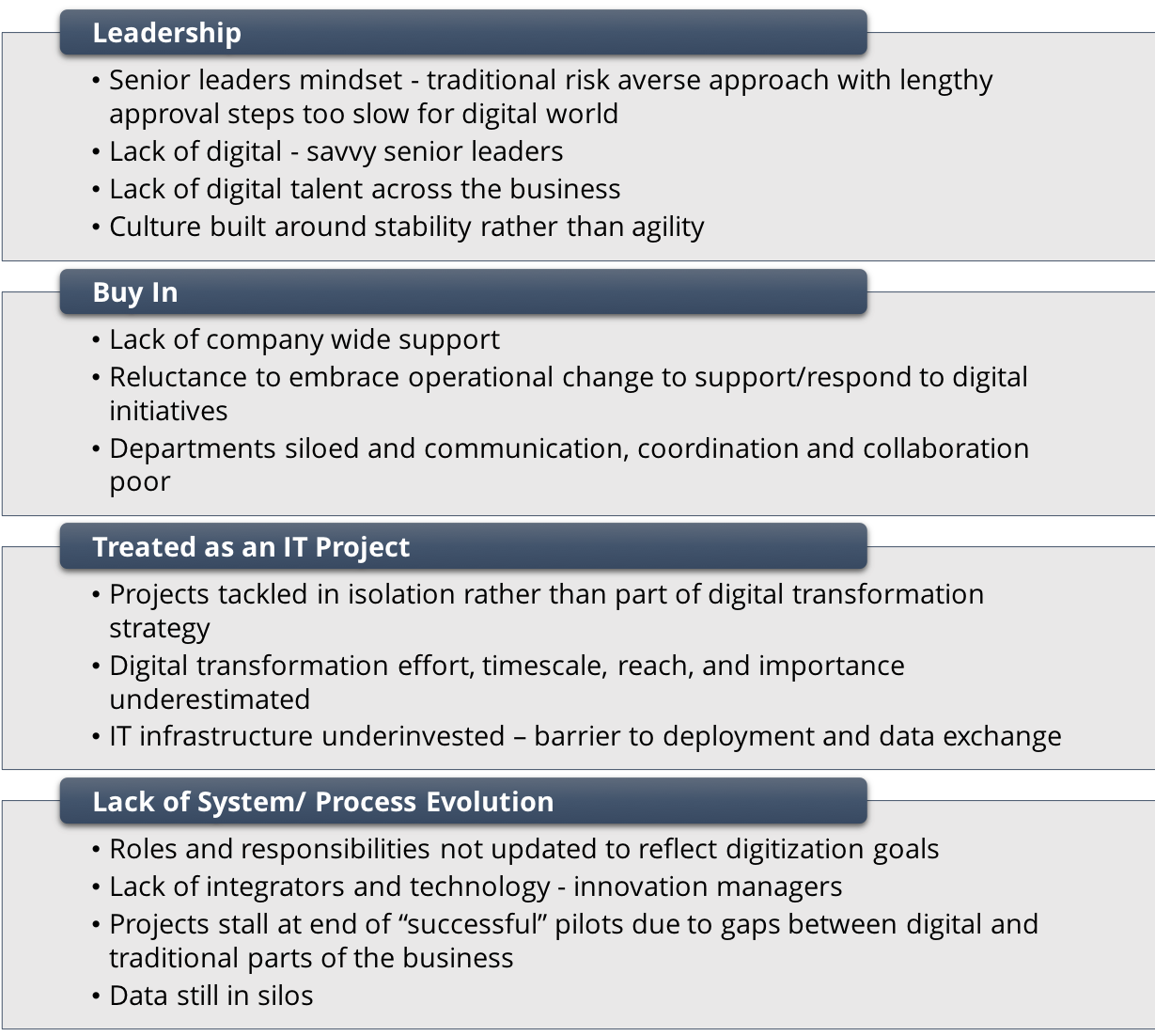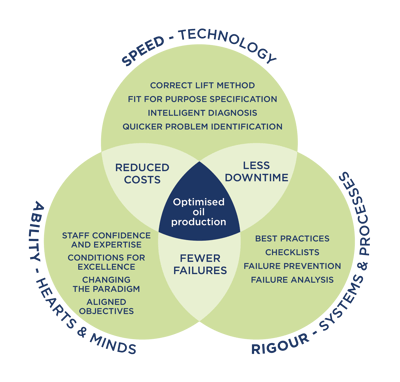Automation, digitalization, machine learning and analytics are seen as the panacea for our industry. But how do we accomplish this?
Here’s an interesting question …who’s leading the digital transformation of your company? Consider these possible answers for your organization:
- Your CEO
- Your CTO
- Your CIO
- Covid-19
There is absolutely no doubt that in recent weeks, Covid-19 has significantly changed the way we can—and—do work. How can we take the lessons we’ve learned under Covid-19 and expand upon them, improving efficiency while driving down our operating costs?
Leveraging Our New Habits for Future Advantage: A Silver Lining?
How does this obligatory revision in our work habits impact the oil and gas industry, and how can we leverage further the benefits of remote working, digitalization and analytics capability?
Many of our clients have been able to transition seamlessly from working in the office to working at home, with access to the same systems. At the beginning of the quarantine, one client told us that our cloud-based system for managing their wells (Pump Checker®), was the only IT system that was working and accessible from home.
Depressed Oil Prices Lead to Modernization, But Not Without People
In April 2020, low oil prices (and even negative oil prices for WTI crude) resulted in many “Digital Transformation” articles suggesting we need to change the way things are done. See Figure 1.

Figure 1 - Fashionable digital transformation themes
One article[1] from Geoffrey Cann, author of Bits, Bytes and Barrels stated:
“It’s become clear that the adoption of new ways of working enabled by digital tools is a critical pathway to lower cost.
Moreover, it turns out that digital innovations are THE key solution to solving the problems of the pandemic AND the cost challenges of the industry. And they’ve been in front of us for a couple of years now.
Those that embrace digital innovations expect cost reductions of 20% or more and productivity gains of 20% or more.”
ALP agrees. Computers and ‘machines’ are far better at watching large well counts, releasing people to perform the value-added work.
Digitalization, analytics, dashboards, management by exception and robust physics-based models are the key to True Production Optimization and lowest total cost of operation.
Hold On…There’s a RIGHT way and a WRONG way to Digitalization
But, before we explore how to make it happen, it’s also worth exploring what doesn’t work and why digitalization projects fail. If your company gets this wrong, you’ll spend a fortune with no benefit. Beware!
Statistics indicate that, in 2018, $1.3 Trillion (USD) was invested in digital transformation initiatives. 70% of these initiatives will not reach their goals due to the failure of digital adoption…that’s $900 Billion of spend that will miss the mark [2].

Figure 2 - Digital transformation failure
For the oil and gas industry, the statistics are worse: 89-96% will not reach goals. That represents a colossal amount of money wasted.
The key point here is that it’s not the digitalization technology that is failing, but rather, the poor adoption due to a lack of ‘Digital Change Management’ within organizations.
Let’s face it, creating organizational or cultural change is difficult! We’re creatures of habit and have the tendency to want to keep doing things the way we’ve always done them.
In an article from Forbes the reasons projects fail are as follows:

Digitalization Comes with Growing Pains
Some additional challenges we face in our industry when we think of digital transformation are:
- There is resistance to automation and digitalization vs. manual processes and the way it has always been done. People are scared that digitalization projects will result in job losses.
- Getting digital transformation right is challenging--it’s not just a question of asking people what they need. As Henry Ford is reputed to have said “If I had asked people what they wanted, they would have said faster horses.” Effective Digital transformation requires a blend of skills from Data Scientists, Petroleum Engineers & Artificial Lift Experts (SME) – all people who talk very different languages, in combination with the correct processes and workflows.
- Our data is not integrated, incomplete and in silos, if it even exists. Oftentimes the information we need is not even in a database.
- Lastly, our sampling frequency of data is low. If you compare an Electric Submersible Pump (ESP) and a formula 1 racecar, the crew of a racecar is getting constant streams of information to optimize the car’s performance. In our industry, we put the ESP 10,000ft in the ground, heat it up to 160oF and then only get a reading from it every 10 minutes. If we spend around $250,000 for an ESP, why don’t we monitor, diagnose and run analytics on it? Similarly, for rod pumps we bring in infrequent cards. Why don’t we bring in high resolution data in the way condition monitoring is applied for surface rotating equipment?
Having been involved in digitalization projects since 2014, as part of implementing our Pump Checker® software for our clients, we have seen many of these issues and know how to overcome them.
Some Ways to Mitigate the Digitalization Challenges
To be successful, the following areas need to be addressed:
- Take your people with you (hearts and minds)
- The correct technology
- Improved systems and processes

Figure 3 – Optimized oil production
Challenges and (Our) Solutions
Here are a few takeaways that we’ve learned, on how to be successful:
Take your people with you
Many time digitalization projects are sold based on “cutting costs,” a statement which makes people fearful for their jobs. We’ve yet to see a digitalization project which requires less people! When done correctly, opportunities and problems are identified quickly, which requires people to ‘process’ the opportunities.
Solution: Digitalization is about communicating improved efficiency. Instead of a pumper going to each well every day for 5 minutes, now he/she just needs to go to 10 wells which have problems but can now spend an hour at each well addressing the issue.
Project champion
Assuming you want project success, a Business User Project Champion is essential. Many time projects languish because management did not have the time to follow up on details, and the company implementing the digital project did not know who to talk to within an organization to get things done.
Solution: Appoint an ‘A player’ project champion, someone who knows the company organization and will take the initiative in solving problems.
Collaboration and one source of truth
Implement a system that integrates all information into one system so that everybody sees the same information. Pumpers, engineer, managers, and vendors can all see the same data whether looking at it on tablet in the field, a laptop in the office, or a smartphone at home.
Solution: Apply a cloud-based solution that enables collaboration
AL information in databases
Your wells have AL equipment installed. An install record may exist somewhere, usually with the vendor, and sometimes within operator systems. That information needs to be available in a database so that it can be used to populate optimization systems.
Solution: Systems like OpenWells® or WellView® should be customized to ensure they can serve up the artificial completion information required to perform well analysis. If that fails, a link to vendor databases is another option.
Well activity and offline status tracked in databases
To understand runlife and time offline when wells fail, details on well activity and offline status needs to be available through databases.
Solution: Integration of production reporting systems and drilling/completion activity provides the required information.
Well test information
Most operators record their oil, water, and gas rates for their wells, but when using artificial lift (AL), don’t record the operating parameters for the lift system. This means that analysis of the well and lift performance is not possible.
Solution: Record AL operating parameters with your well tests.
Realtime data - knowing what to bring in
Operators install expensive SCADA or automation systems, but often fail to bring in a complete dataset. After spending $10million on fracking and completing a well, we fail to spend $1,000 to install a wellhead pressure transducer to bring in wellhead pressure and temperature. Knowing your wellhead pressure and wellhead temperature is the starting point for diagnosis/nodal calculations of lift performance.
Solution: Get SME experience involved to ensure you bring in the correct parameters.
Data Aggregation and Integration
When using third parties to collect data, many times they use the well name or their own reference number to identify the well data. This makes it very difficult to integrate the data with your own systems.
Solution: Use a unique reference number across all systems. Either an API number or an accounting code are good options.
Engineers love Excel
There is no getting away from it - Engineers love excel. Make it easy to get data in and out of digital platforms using excel. That was one of the deliberate decisions we made as part of the development of our software – we have an export to excel button on almost every screen.
Solution: Make export and import of data easy, but don’t keep your processes in excel.
Train, train, train
A one-time training session doesn’t work. People get overwhelmed quickly and stop paying attention. A one-hour class, every day for a week is more beneficial than a single day 8-hour class. Remote working lends itself to a little and often. A coach I worked with used to say: “the first law of learning is recognition and the second law is repetition”. So true.
Solution: Train frequently and often, but for short periods of time.
Build the new road, then tear out the old road
Once you have your new digital solutions in place you need to get rid of the old way of doing things. If the old way still exists, people will keep doing things the old way.
Solution: Build the new system, test, implement and then flip the switch.
A Change in Mindset—and Processes—is Necessary for Digitalization
The issue and solutions identified above are very specific to digital transformation for Artificial Lift, our area of expertise. However, some general learnings applicable for any such projects are:
- Start with the end in mind
- Develop digital mindset of leadership (bring in digital-savvy leaders and SMEs)
- Create a strategy for a digital world, rather than a digital strategy
- Chunk. Empower employees to experiment and co-create and learn from their failures (Agile approach - FAIL early, FAIL fast, FAIL forward)
- Create a sense of urgency for making the chunks happen
- Establish digital vision (and relate projects to that vision)
- Restructure to a data-first culture (Realtime data and evidence-based decision making)
- Command collaboration across the organization – silo removal
- Encourage employees to challenge old ways of working and provide opportunities to generate ideas of where digitalization might support the business
- Implement digital tools to make information more accessible across the organization
One of our clients had 130 wells when we began working with them. Getting our arms around that volume of data manually was unmanageable. The solution was to link production information, well servicing records and completion information, and artificial lift data to Pump Checker so that the data updated automatically. The process worked and 550 ESP wells are now kept updated effortlessly every day. If you’d like to know more about how to do this, please contact us.
The key themes and ideas from this blog were originally presented at the 9th Annual Middle East Artificial Lift Forum (MEALF) in December 2019 in Oman. I had the honor of being invited to participate in the opening panel session on Digitalization for Future Energy.
On a Side Note, AKA “Bonus Material”
If you’ve never been to Oman, treat yourself and visit the country. The people are incredibly warm and friendly; Muscat is gorgeous. Outside of Muscat, the geology of the mountains is amazing, which makes for great hiking and some luxury hotels. An early morning walk or run along the beach in Muscat is highly energizing and beautiful.
References
- Only The Low Cost Survive, Geoffrey Cann Blog, 11 May 2020,
- https://www.bain.com/insights/big-data-analytics-in-oil-and-gas/
- Why Digital Transformations Fail: Closing The $900 Billion Hole In Enterprise Strategy, Forbes Technology Council
- Unlocking success in digital transformations, McKinsey & Company
.jpg?width=2097&height=770&name=ALP%20logo%20%26%20strapline%20-%20RGB%20(US%20version).jpg)

